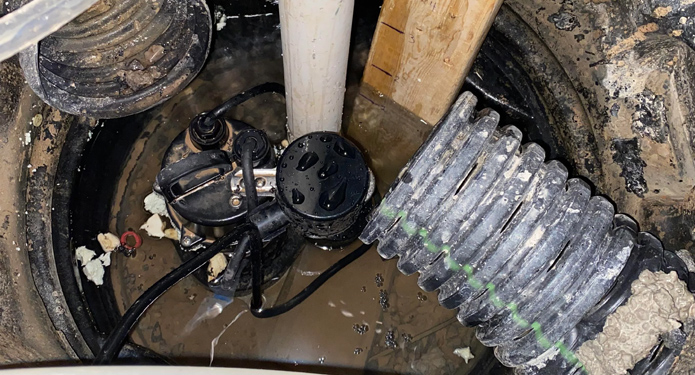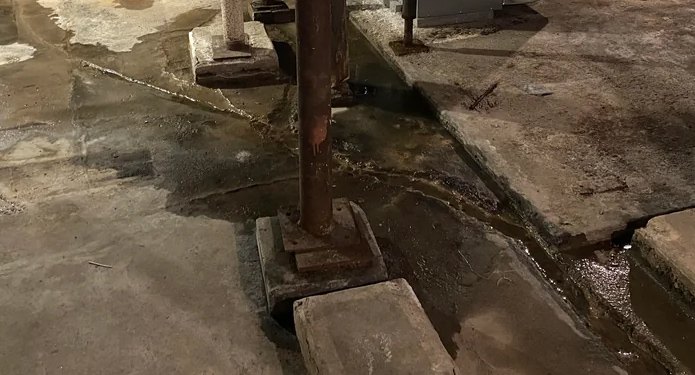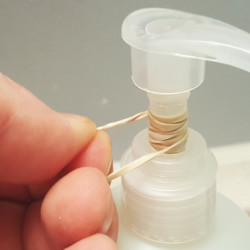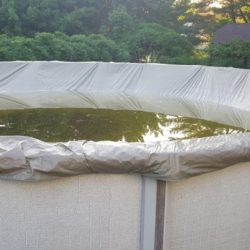
If you have a wet basement, then chances are you also have a sump pump that works hard on a regular basis. You may be wondering how long it will last, or you may be curious about what you can do if it ever stops working. Hopefully you’re not involved in an emergency situation right now, but if you are, the info that follows may just save the day. If the water level is rising because the pump is broken, continue reading to find out what your options are, and how you might prevent a similar problem in the future. When your basement is currently flooding, the most important thing is to stop the flow if possible, then get the water out of your basement as fast as possible.
If your sump pump has stopped working, there will be few realistic options to fix it and get it working again, so the ultimate fix will be to replace the pump with a new one. While you wait for the repairman, or while you wait for the store to open, you can still get to work drying out your basement, and removing the excess water, and the more you accomplish, the better off you and your basement will be in the long run.

What Is A Sump Pump?
A sump pump is a device used to remove water that has accumulated in a sump pit, typically found in basements or crawl spaces. These pits are designed to collect excess water, either from natural groundwater or from drainage systems around the foundation of a building.
The sump pump is placed at the lowest point of the pit, where water naturally flows. When the water level in the pit reaches a certain height, a float switch or sensor triggers the pump to activate. The pump then pumps the water out of the pit and away from the building, usually through a discharge pipe that leads to a storm drain, a dry well, or another area where the water can safely drain away from the property.
Sump pumps are essential for preventing water damage to basements and crawl spaces, particularly in areas prone to flooding or with high water tables. They help to keep these areas dry and protect them from water infiltration, which can lead to mold, mildew, and structural damage if left unchecked.
How Long Do Sump Pumps Last?
The lifespan of a sump pump can vary depending on several factors, including the quality of the pump, how often it operates, the level of maintenance it receives, and the conditions of the environment in which it is installed. However, on average, a well-maintained sump pump can last anywhere from 5 to 15 years.
Here are some factors that can influence the lifespan of a sump pump:
- Quality of the Pump: Higher-quality sump pumps made with durable materials and components tend to last longer than cheaper, less reliable models. Investing in a reputable brand and a pump with a good track record can extend its lifespan.
- Frequency of Use: Sump pumps that operate more frequently due to high water tables, heavy rainfall, or poor drainage systems may experience more wear and tear, potentially shortening their lifespan. Conversely, pumps that only operate occasionally may last longer.
- Maintenance: Regular maintenance, including cleaning the pump and pit, testing the pump’s operation, and replacing worn-out parts, can help prolong the life of a sump pump. Neglecting maintenance can lead to premature failure.
- Power Supply: Sump pumps that experience power outages or electrical issues may be at risk of failure if they are unable to operate when needed. Installing a backup power source, such as a battery backup or generator, can help ensure continuous operation during emergencies.
- Environmental Conditions: Factors such as the presence of debris, sediment, or corrosive materials in the water, as well as extreme temperatures or humidity levels in the environment, can affect the performance and longevity of a sump pump.
It’s essential to monitor the condition of your sump pump regularly and replace it before it fails to prevent potential water damage to your property. If you notice any signs of malfunction or if your pump is approaching the end of its expected lifespan, it’s a good idea to replace it proactively rather than waiting for it to fail unexpectedly.
Can You Fix a Broken Sump Pump?
In many cases a broken pump CAN be fixed, but you should first determine whether it is worth it or not. With a broken sump pump and a wet basement, speed of remedy is perhaps the most import thing to consider, but there are other factors that may affect your decision too. Whether to fix or replace a broken sump pump depends on the extent of the damage, the age of the pump, and the cost of repairs compared to the cost of a new pump. Here are some factors to consider when making this decision:
- Extent of Damage: If the sump pump has minor issues, such as a clogged impeller or a malfunctioning float switch, it may be possible to repair it relatively easily and cost-effectively. However, if the damage is extensive, such as a burned-out motor or a cracked housing, repair may not be feasible or cost-effective.
- Age of the Pump: If the sump pump is nearing the end of its expected lifespan or has already exceeded it, it may be more practical to replace it rather than investing in repairs that may only provide a temporary solution. Older pumps are also more likely to experience further issues in the future.
- Cost of Repairs: Consider the cost of repairing the sump pump compared to the cost of purchasing a new one. In some cases, the cost of repairs may be prohibitively high, making replacement the more economical choice.
- Reliability: Even if repairs are possible, there is no guarantee that the pump will continue to function reliably after being repaired. If you have concerns about the pump’s reliability or if it has a history of frequent breakdowns, replacing it with a new, more reliable model may be the better option.
- Warranty: Check if the sump pump is still under warranty, as repairs may be covered by the manufacturer if the pump is still within the warranty period. However, keep in mind that warranties typically do not cover normal wear and tear or damage caused by improper use or neglect.
In general, if the sump pump is relatively new and the cost of repairs is reasonable compared to the cost of replacement, repairing it may be a viable option. However, if the pump is old, extensively damaged, or likely to experience further issues, replacing it with a new pump may be the more practical choice for ensuring reliable water management and preventing potential water damage to your property.

Getting Water Out Of Your Basement Without a Sump Pump
When a sump pump fails, it can leave your basement vulnerable to water damage from flooding or excessive moisture buildup. In such situations, it’s crucial to act quickly to remove water from the basement to prevent further damage to your property. Fortunately, there are several methods available for getting water out of a basement when the sump pump fails, each with its own advantages, disadvantages, and considerations.
Methods for Removing Water from a Basement:
- Manual Pump
- Ease: Moderate
- Cost: Low to moderate
- Complexity: Low
- Description: A manual pump, such as a hand-operated bilge pump or a portable utility pump, can be used to manually remove water from the basement. These pumps typically require physical effort to operate but can be effective for removing moderate amounts of water.
- Wet/Dry Vacuum
- Ease: Moderate
- Cost: Moderate
- Complexity: Low
- Description: A wet/dry vacuum equipped with a hose attachment can be used to suction water out of the basement. This method is relatively easy to use and can quickly remove water from surfaces such as floors and carpets.
- Mop and Bucket
- Ease: Low to moderate
- Cost: Low
- Complexity: Low
- Description: Mopping up standing water with a bucket and mop is a simple and inexpensive method for removing water from the basement. While it may be time-consuming for larger areas, it can be effective for smaller spills or shallow flooding.
- Sump Pump Backup System
- Ease: Moderate to high
- Cost: Moderate to high
- Complexity: Moderate
- Description: Installing a sump pump backup system, such as a battery backup pump or a water-powered backup pump, can provide an additional layer of protection in case the primary sump pump fails. These systems automatically activate in the event of a power outage or pump failure to remove water from the basement.
- Towels and Sponges
- Ease: Low
- Cost: Low
- Complexity: Low
- Description: Absorbent towels and sponges can be used to soak up standing water from surfaces in the basement. While this method may be labor-intensive and time-consuming, it can be effective for small spills or localized flooding.
What to Do When There Is Electricity:
If electricity is available during a sump pump failure, you can utilize the following methods to remove water from the basement:
- Use a manual pump, wet/dry vacuum, or mop and bucket to manually remove water.
- Consider installing a sump pump backup system to provide additional protection against pump failures.
What to Do When There Is No Electricity:
In the event of a power outage or electrical failure, you can still take the following steps to remove water from the basement:
- Use a manual pump or hand-operated bilge pump to manually remove water.
- Utilize towels, sponges, or a mop and bucket to absorb and remove standing water.
- Consider investing in a battery backup pump or a water-powered backup pump to provide emergency pumping capabilities during power outages.
When faced with a sump pump failure, it’s essential to act quickly to remove water from the basement and minimize the risk of water damage to your property. By utilizing a combination of manual pumping methods, wet/dry vacuums, absorbent materials, and backup pumping systems, you can effectively manage and mitigate the effects of pump failures on your basement. Additionally, regular maintenance and inspection of your sump pump system can help prevent failures and ensure reliable water management in the future.
Can You Siphon Water Out Of A Basement?
Yes, you can siphon water out of a basement as a method of removing excess water when dealing with a sump pump failure or flooding. Siphoning involves using gravity to create a vacuum that draws water from one location to another. While siphoning can be effective for removing water, especially in situations where other methods are unavailable or impractical, there are several important considerations to keep in mind:
- Location of Water Source: The effectiveness of siphoning depends on the location of the water source relative to where you want to discharge the water. The water source must be higher than the discharge point to create the necessary gravity flow.
- Siphon Length and Elevation: The length and elevation difference between the water source and the discharge point will affect the efficiency of the siphon. Longer siphon hoses or greater elevation differences may require more effort to start the siphon and maintain the flow of water.
- Siphon Hose: You’ll need a suitable hose to create the siphon. The hose should be long enough to reach from the water source to the desired discharge point. Additionally, ensure that the hose is clean and free of any debris or obstructions that could disrupt the flow of water.
- Starting the Siphon: To start the siphon, you’ll need to fill the hose completely with water to create a continuous flow. This can be done by submerging the entire length of the hose in the water source and then quickly sealing one end before raising it above the water level to allow gravity to pull the water through.
- Monitoring the Siphon: Once the siphon is established, monitor it closely to ensure that it continues to function properly. Any interruptions in the flow of water, such as air bubbles entering the hose or obstructions blocking the flow, can disrupt the siphon and may require restarting it.
- Discharge Point: Determine a suitable discharge point for the water where it can safely drain away from the property without causing further damage or creating hazards. Ensure that the discharge point is lower than the water source to maintain the flow of water through the siphon.
While siphoning can be an effective method for removing water from a basement in certain situations, it may not be suitable for large volumes of water or situations where the water source is significantly higher or lower than the discharge point. In such cases, alternative methods such as manual pumping, wet/dry vacuuming, or utilizing a backup sump pump system may be more practical and efficient for water removal.

A Fast And Easy Way To Dry The Floor
Combining a rubber broom with a squeegee and a super shammy creates a powerful and efficient solution for eliminating leftover standing water and drying floors. Here’s why this combo is the best choice:
Versatility
The rubber broom with a squeegee attachment offers versatility in tackling various types of surfaces, including hardwood, tile, concrete, and carpet. The rubber bristles effectively sweep away water, while the squeegee efficiently pushes water towards the desired direction, making it easy to control the flow and direction of water removal.
Efficiency
Rubber brooms are designed to attract and capture water, dirt, and debris effectively. The flexible rubber bristles conform to uneven surfaces, ensuring thorough cleaning and removal of water without scratching or damaging the floor. Additionally, the squeegee attachment helps to gather water into manageable puddles for quick and efficient removal.
Durability
Rubber brooms are built to last, featuring durable materials that withstand frequent use and heavy-duty cleaning tasks. The rubber bristles are resilient and resistant to wear and tear, ensuring long-term performance and reliability. Likewise, the super shammy is highly absorbent and durable, capable of soaking up large amounts of water without losing its effectiveness.
Ease of Use
Using a rubber broom with a squeegee and a super shammy is incredibly easy and convenient. The lightweight design and ergonomic handle make it comfortable to use for extended periods without causing fatigue or strain. The combination of sweeping, squeegeeing, and drying with the shammy allows for efficient water removal and floor drying in minimal time and effort.
Environmentally Friendly
Unlike disposable cleaning products that contribute to waste and pollution, rubber brooms and super shammys are reusable and eco-friendly. By investing in durable, long-lasting cleaning tools, you reduce your environmental impact and save money in the long run by eliminating the need for disposable alternatives.
Cost-Effectiveness
While the initial investment in a rubber broom with a squeegee and super shammy may be slightly higher than purchasing disposable cleaning supplies, the long-term cost-effectiveness of these reusable tools quickly becomes apparent. You’ll save money over time by eliminating the need for frequent replacements and disposable products, making it a smart and economical choice for homeowners and businesses alike.
In conclusion, the combination of a rubber broom with a squeegee and a super shammy offers unmatched efficiency, durability, and versatility for eliminating leftover standing water and drying floors. Whether you’re dealing with spills, floods, or routine cleaning tasks, this combo provides a reliable and effective solution for maintaining clean, dry, and safe floors with minimal effort and maximum convenience.
How To Do It:
Here’s a step-by-step guide on how to dry the floor effectively using a rubber broom with a squeegee and a super shammy:
- Assess the Area: Begin by assessing the extent of the water on the floor. Determine the areas that require drying and identify any obstacles or objects that may hinder the process.
- Prepare Your Tools: Gather your rubber broom with a squeegee attachment and a super shammy. Ensure that both tools are clean and free of debris to optimize their effectiveness.
- Sweep with the Rubber Broom: Start by using the rubber broom to sweep the water towards a central location or towards the nearest drain. The flexible rubber bristles will attract and capture the water, making it easier to collect.
- Use the Squeegee: Flip to the squeegee side to move water efficiently and thoroughly dry floors. Once the water is gathered into a manageable puddle, use the squeegee to push the water towards the desired direction, such as a floor drain or an exit point.
- Repeat as Needed: Continue sweeping and squeegeeing the floor until the majority of the water is removed. Depending on the size of the area and the amount of water present, you may need to repeat this step multiple times to ensure thorough drying.
- Absorb Excess Water with the Super Shammy: Once the bulk of the water is removed, use the super shammy to absorb any remaining moisture and dry the floor completely. Lay the shammy flat on the floor and press down firmly, allowing the absorbent material to soak up the water.
- Wring Out the Shammy: Periodically wring out the super shammy to remove absorbed water and maximize its drying capacity. Continue drying the floor with the shammy until it feels dry to the touch and no visible water remains.
- Inspect for Any Remaining Wet Spots: After drying the floor, inspect the area for any remaining wet spots or moisture. Pay close attention to corners, edges, and low-lying areas where water may accumulate.
- Allow Time for Air Drying (Optional): If necessary, allow the floor to air dry for additional time to ensure complete drying. Open windows or doors to promote air circulation and expedite the drying process.
- Clean and Store Your Tools: Once the floor is completely dry, clean and store your rubber broom, squeegee, and super shammy for future use. Rinse the tools with water and mild detergent if needed, and allow them to air dry before storing them in a clean, dry area.
By following these step-by-step instructions, you can effectively dry the floor using a rubber broom with a squeegee and a super shammy, leaving your floors clean, dry, and free of standing water.
A Fast and Effective Manual Pump
The Slide-N-Pump is a manual pump designed for emergency water removal, and it offers several features that make it an excellent choice for situations like when a sump pump fails in your basement. Here’s why the Slide-N-Pump would make the perfect manual pump for moving water in such emergencies:
- No Electricity Required: One of the primary advantages of the Slide-N-Pump is that it operates without the need for electricity. In the event of a power outage or sump pump failure, you can rely on the Slide-N-Pump to remove water from your basement without being dependent on electrical power.
- Portable and Lightweight: The Slide-N-Pump is portable and lightweight, making it easy to transport and maneuver, even in tight spaces such as basements or crawl spaces. Its compact design allows for convenient storage when not in use and easy access during emergencies.
- Simple and Easy to Use: The Slide-N-Pump features a straightforward design that is easy to understand and operate, making it accessible to homeowners of all skill levels. It requires minimal assembly and can be set up quickly, allowing you to start removing water from your basement promptly.
- Versatile Applications: In addition to removing water from basements, the Slide-N-Pump can be used for various other water removal tasks, such as draining pools, spas, ponds, or boats. Its versatility makes it a valuable tool to have on hand for a wide range of emergency situations and everyday maintenance tasks.
- No Priming Required: Unlike some manual pumps that require priming to start the flow of water, the Slide-N-Pump does not need priming. This eliminates the need for additional steps or equipment and ensures quick and efficient water removal without delay.
- Durable and Reliable: Constructed from high-quality materials, the Slide-N-Pump is durable and built to withstand rugged use in challenging conditions. Its sturdy construction ensures long-lasting performance and reliability, providing peace of mind during emergencies.
- Cost-Effective Solution: Compared to more complex and expensive pump systems, the Slide-N-Pump offers a cost-effective solution for emergency water removal. Its affordable price point makes it accessible to homeowners on a budget, providing an efficient and reliable option for handling sump pump failures and other water-related emergencies.
Overall, the Slide-N-Pump is an ideal choice for manually removing water in emergencies like when a sump pump fails in your basement. Its simplicity, portability, reliability, and affordability make it a valuable tool for homeowners seeking a practical solution for handling unexpected water issues with ease and efficiency.
What Happens If You Don’t Fix a Broken Sump Pump?
This is not a job you want to wait on. If you have a really wet basement, you’ll be able to see the water level rising, but even if it’s just moist, the damage will start immediately, and only get worse with time. The faster you go about fixing the pump and drying out your basement, the better off you’ll be. In case you were considering just closing the door and forgetting about what’s going on down there, the following repercussions may help to change your mind.
If you don’t fix a broken sump pump, several potential consequences can occur, leading to various problems and risks for your home and property. Here are some of the potential outcomes of neglecting to address a broken sump pump:
Increased Risk of Basement Flooding
The primary function of a sump pump is to remove excess water from the basement, preventing flooding and water damage. If the sump pump remains broken or non-functional, water can accumulate in the sump pit and overflow into the basement during heavy rainfall or when groundwater levels rise. This can result in significant water damage to floors, walls, furniture, appliances, and personal belongings stored in the basement.
Mold and Mildew Growth
Excess moisture and standing water in the basement provide ideal conditions for mold and mildew growth. Mold and mildew can thrive on organic materials such as wood, drywall, carpeting, and insulation, leading to health hazards and structural damage. Prolonged exposure to mold spores can cause respiratory issues, allergies, and other health problems for occupants of the home.
Structural Damage
Water infiltration and prolonged moisture exposure can weaken the structural integrity of the basement walls, floors, and foundation. Over time, this can lead to cracks, bowing, or shifting in the foundation, compromising the stability and safety of the entire structure. Repairing structural damage can be costly and time-consuming, requiring professional intervention to address the underlying issues.
Damage to Electrical Systems
Flooding in the basement can pose a risk to electrical systems and appliances, increasing the likelihood of electrical shocks, short circuits, and fires. Water damage to electrical components, such as circuit breakers, wiring, outlets, and appliances, can render them inoperable and necessitate costly repairs or replacements.
Decreased Property Value
Persistent water damage and unresolved issues with the sump pump can detract from the overall value and appeal of the property. Potential buyers may be deterred by the presence of water damage, mold growth, and structural issues, leading to difficulty selling the home and potentially lower offers.
Insurance Coverage Issues
Neglecting to address a broken sump pump and resulting water damage may affect your ability to file insurance claims and receive coverage for repairs and restoration. Some insurance policies may exclude coverage for water damage caused by neglected maintenance or pre-existing conditions, leaving you responsible for covering the costs out of pocket.
Overall, neglecting to fix a broken sump pump can lead to a range of detrimental consequences, including basement flooding, mold growth, structural damage, electrical hazards, decreased property value, and insurance coverage issues. It’s essential to address sump pump issues promptly and perform regular maintenance to prevent potential problems and protect your home and property from water-related damage and risks.
How To Prevent Sump Pump Failure In The Future
Preventing and preparing for sump pump failure is essential to minimize the risk of water damage to your basement and property. Here are some proactive steps you can take to prevent sump pump failure and prepare for potential emergencies:
Regular Maintenance
Schedule regular maintenance for your sump pump to ensure it remains in good working condition. This includes cleaning the pump and pit, checking for debris or obstructions, testing the pump’s operation, and inspecting for signs of wear or damage. Follow the manufacturer’s recommendations for maintenance intervals and procedures.
Install a Backup Pump
Installing a backup sump pump system provides an additional layer of protection in case the primary pump fails or during power outages. Options include battery backup pumps, water-powered backup pumps, or combination systems that utilize both. Choose a backup system that suits your needs and budget and ensure it is installed correctly.
Maintain Power Supply
Ensure that your sump pump has a reliable power source to operate effectively. Consider installing a dedicated circuit for the sump pump to prevent tripped breakers or power interruptions. Additionally, invest in a backup power source such as a generator or uninterruptible power supply (UPS) to keep the pump running during power outages.
Install a High Water Alarm
A high water alarm alerts you to rising water levels in the sump pit, providing early warning of potential pump failure or flooding. Install a high water alarm system in your basement and test it regularly to ensure it is functioning correctly. Consider choosing an alarm with battery backup or connectivity to a home security system for added reliability.
Maintain Proper Drainage
Ensure that your property has proper drainage systems in place to prevent water from pooling around the foundation and entering the basement. Keep gutters and downspouts clean and free of debris, extend downspouts away from the foundation, and grade the soil away from the house to direct water flow away from the basement.
Inspect Check Valve
The check valve prevents water from flowing back into the sump pit once it has been pumped out. Inspect the check valve periodically to ensure it is functioning correctly and replace it if necessary to maintain proper pump operation.
Monitor Weather Conditions
Stay informed about weather forecasts and potential flooding risks in your area. Take preventive measures such as installing a sump pump alarm, elevating appliances and valuable items, and sealing basement windows and doors to minimize the risk of water intrusion during heavy rainfall or storms.
Create an Emergency Plan
Develop an emergency plan that outlines steps to take in the event of sump pump failure or flooding. Include contact information for emergency services, utility providers, and professional restoration companies. Keep essential supplies such as a portable pump, sandbags, and emergency lighting readily available.
By following these preventive measures and preparing for potential emergencies, you can minimize the risk of sump pump failure and mitigate the effects of water damage to your basement and property. Regular maintenance, installation of backup systems, and proactive planning are key components of effective sump pump management and protection against water-related emergencies.
Avoid disaster in an emergency by taking the correct steps when your sump pump fails. You can’t stop the moisture in all cases, so do what you can to remove it manually until you get the pump fixed or replaced. There are several techniques that you can use to get the water out of your basement, and you’ll want to select the best option for you based on how wet your basement is, what kind of stuff you have on hand, and whether or not you currently have electricity. If you wait to take action you’ll probably regret it, so get to work drying out your basement now, and worry about getting the pump running again when you can.
Have a better way to dry out a basement, or manually pump out water? We tried to outline all options above, but if you have a special tool or technique to recommend, use the comments section below.
Products Mentioned
- Rubber Broom
- Super Shammy
- Slide-N-Pump – Manual Water Pump





 Ordering Info
Ordering Info Customer Service
Customer Service Follow Us
Follow Us Search For Stuff
Search For Stuff Find Us
Find Us Call Us
Call Us Pay Us
Pay Us

0 Comments so far.
Use the form below to add your own thoughts or questions. Scroll down to read what other people had to say.